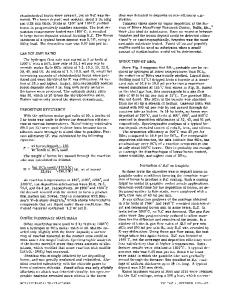Chemical Vapor Deposition of an Iridium Phase on Hafnium Carbide and Tantalum Carbide
- PDF / 1,506,165 Bytes
- 8 Pages / 612 x 792 pts (letter) Page_size
- 53 Downloads / 334 Views
GANIC MATERIALS AND NANOMATERIALS
Chemical Vapor Deposition of an Iridium Phase on Hafnium Carbide and Tantalum Carbide V. V. Lozanova, *, I. Yu. Il’inb, N. B. Morozovab, S. V. Trubinb, and N. I. Baklanovaa aInstitute
of Solid State Chemistry and Mechanochemistry, Siberian Branch of the Russian Academy of Sciences, Novosibirsk, 630128 Russia b Nikolaev Institute of Inorganic Chemistry, Siberian Branch of the Russian Academy of Sciences, Novosibirsk, 630090 Russia *e-mail: [email protected]
Received May 28, 2020; revised June 10, 2020; accepted June 26, 2020
Abstract—Nanocrystalline iridium coatings on hafnium carbide and tantalum carbide substrates are prepared by chemical vapor deposition (MOCVD) at 600°С. Subsequent high-temperature treatment at 1100°С gives rise to chemical reactions between iridium and hafnium carbide or tantalum carbide to yield nanosized substitutional intermetallic solid solutions MIr3 – x and evolve free carbon. The occurrence of intermetallic interaction is proved by X-ray photoelectron (XPS) spectroscopy. Keywords: chemical vapor deposition, X-ray photoelectron spectroscopy DOI: 10.1134/S0036023620110108
INTRODUCTION Carbides and borides of hafnium and tantalum are widely used in advanced materials science for design of high-temperature materials and coatings intended for performance in extreme settings [1–3]. However, their potential is not exhausted by high-temperature applications. Recent studies showed that carbides and borides of tantalum and hafnium can be successfully used to create solar energy converters as materials that absorb solar radiation in a wide spectral range [4, 5]. Thermionic emission properties and metallic thermal and electrical conductivity allow refractory carbides to be used as field-emission cathodes, as well as in the design of high-temperature MOSFET devices in microelectronics [6, 7]. Some technological problems require a decrease in the electron work function of the carbide [7]. Kan and Kul’varskaya [8] observed an increased emission current in transition-metal carbides after applying an iridium film and thermal activation, due to a decreased surface work function. In view of the fact that thermionic properties are activated at temperatures of 1000°С or higher, the evaluation of the performance of such devices should take into account the process that can occur at the iridium film–carbide substrate interface. We have previously studied the interaction between iridium powders and hafnium carbide and tantalum carbide powders [9, 10]. We showed in those studies that the interaction was noticeable even at 1000–1100°С and involved the formation of intermetallic solid solutions MIr3 ± x and evolution of free carbon.
The goal of the work we report on here was to understand the details of interactions of iridium with tantalum carbide and hafnium carbide at 1100°С based on the morphology, phase and elemental composition, and the chemical states of constituent elements. The model subject matter used was the diffusion pair comprised of a thin iridium coating (pr





